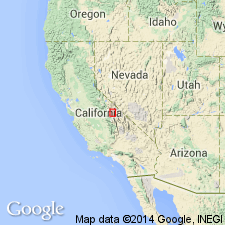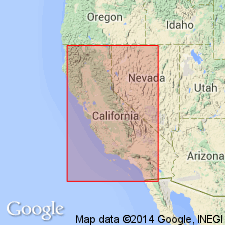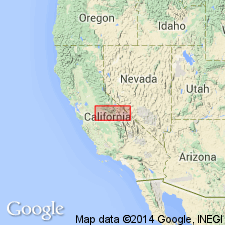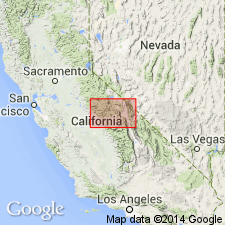
- Usage in publication:
-
- Lamarck Granodiorite*
- Modifications:
-
- Named
- Dominant lithology:
-
- Granodiorite
- AAPG geologic province:
-
- Sierra Nevada province
Summary:
Named after Mount Lamarck. Type locality: cirques east of Mount Lamarck [37 deg 11' 42"N, 118 deg 40' 13"W, Mount Goddard 15' quad, Inyo Co, CA]. Crops out along west and southwest of mapped area. Mount Lamarck mass underlies about 54 sq mi in southwest part; Chickenfoot Lake mass underlies 3 sq mi in northwest part. Homogeneous in composition and texture except in thin southeast part, which is more felsic and somewhat porphyritic. Younger than Inconsolable and Tinemaha Granodiorite (both new) and older than granodiorite of Cartridge Pass, Tungsten Hills Quartz Monzonite (new) and quartz monzonite similar to Cathedral Peak Granite. Is Cretaceous age.
Source: GNU records (USGS DDS-6; Menlo GNULEX).

- Usage in publication:
-
- Lamarck Granodiorite*
- Modifications:
-
- Geochronologic dating
- AAPG geologic province:
-
- Sierra Nevada province
Summary:
Sample 1601 of Lamarck Granodiorite collected at 12,880 ft elev from Lamarck Col, Mount Goddard 15' quad, CA gave K-Ar age of 82.5 Ma on biotite. Age changed from Cretaceous to Late Cretaceous.
Source: GNU records (USGS DDS-6; Menlo GNULEX).

- Usage in publication:
-
- Lamarck Granodiorite*
- Modifications:
-
- Geochronologic dating
- AAPG geologic province:
-
- Sierra Nevada province
Summary:
Is included in informally named Powell granitoid sequence. Sample 49 (location shown on map) of Lamarck Granodiorite gave Pb-U and Pb-Th ages of 89.6 to 86.9 Ma.
Source: GNU records (USGS DDS-6; Menlo GNULEX).

- Usage in publication:
-
- Lamarck Granodiorite*
- Modifications:
-
- Revised
- AAPG geologic province:
-
- Sierra Nevada province
Summary:
Included as oldest unit of John Muir Intrusive Suite. Forms thin lenticular pluton more than 60 km long and 10 km wide. Rock is homogeneous in composition and texture but core is more leucocratic; SW end is also weakly megacrystic. Intrudes Inconsolable Quartz Monzodiorite. Also intrudes Tinemaha Granodiorite (of Palisade Crest Intrusive Suite). Intruded by Mount Givens Granodiorite and Lake Edison Granodiorite (new) and Evolution Basin Alaskite (of John Muir Intrusive Suite) (new). Also intruded by granodiorite of Cartridge Pass. Has U-Pb age of 90 Ma (Stern and others, 1981). Age is Late Cretaceous.
Source: GNU records (USGS DDS-6; Menlo GNULEX).
For more information, please contact Nancy Stamm, Geologic Names Committee Secretary.
Asterisk (*) indicates published by U.S. Geological Survey authors.
"No current usage" (†) implies that a name has been abandoned or has fallen into disuse. Former usage and, if known, replacement name given in parentheses ( ).
Slash (/) indicates name conflicts with nomenclatural guidelines (CSN, 1933; ACSN, 1961, 1970; NACSN, 1983, 2005, 2021). May be explained within brackets ([ ]).

